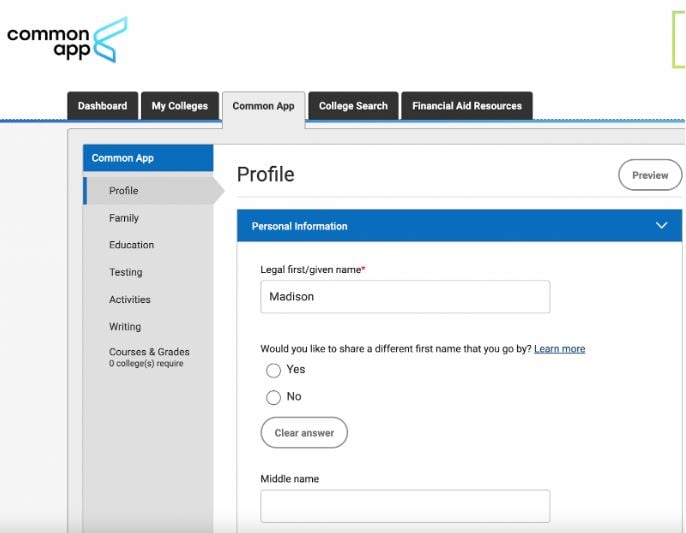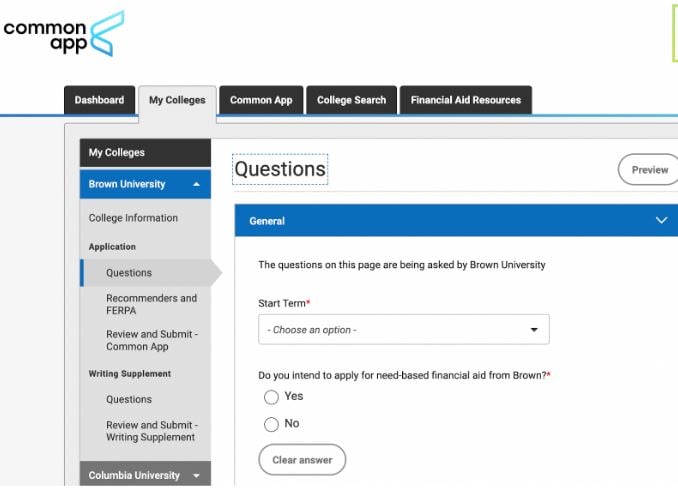- Leave a Comment
- August 17 2022
- College Applications
- By vanguard
How to Common App
How to Common App
So you’ve finally arrived at your senior year. Congratulations! The only thing standing between you and your dream school is approximately a dozen essays, eight more months of high school, a handful of recommendation letters, and three little words: The Common App.
Believe it or not, the Common App is there to make your life easier. It’s a standardized and centralized portal that allows you to use one application to apply to any of its 1,000+ participating schools from around the country. The Common App consists of two components:
- Common Application materials, which will be uniformly submitted to each school to which you’re applying.
- College-Specific Application materials, which will vary depending on where you’re applying.
Here’s a crash course on each section of the application, and where to find them:

Common Application
The Common Application materials can be found under the Common App tab (see above). Here are the sections you’ll have to fill out:
1. Personal Information & Family Background
These sections are pretty straightforward. Name, birthday, demographic information, your parents’ names and education histories, and all that jazz.
2. Educational Background & Course Schedule:
When you ask your school counselor to send your official transcripts to colleges, they’ll likely only reflect 9th-11th grade. So it’s important to report your first-semester senior schedule accurately in order to show colleges which courses you will complete before graduation. Don’t abbreviate course names; spell them out to avoid any confusion.
3. Test Scores
Many schools in post-covid years have gone “test optional,” meaning they allow students the choice of whether or not to submit their SAT/ACT scores. Keep in mind, though, that some schools (like Georgia Tech and MIT) are dropping their test-optional policies this year.
All your schools are still test-optional? Before you ditch your scantrons and study sessions, think twice. Test-optional policies have actually contributed to plummeting acceptance rates at schools around the country. These days, submitting a solid score could really set you apart from other applicants.
We recommend giving the SAT or ACT your best shot or two before making a decision. If you decide to not submit your scores to any schools, or to submit your scores to only the schools with lower score standards, check “no” in this section.
4. Extracurricular Activities
Stick to the most important points when writing your descriptions. Basically, think in Tweets; you’re only allowed 150 characters.
For example, a strong description for a volunteer position where you helped out with community events at a local library might look something like this:
“Planned and coordinated public events for 50+ children ages 4-12, aimed at inspiring a love for reading. Created promotional posts for social media.”
5. Personal Narrative Essay
You’ll find the narrative essay prompts under the “Writing” tab. Be sure to budget plenty of time–we’re talking weeks or months, if possible– for your essay. They’re the main impression college admissions officers will have of who you are as a person, beyond a name on a page and a string of numbers representing your GPA and test scores.

College-Specific Application
After you’ve finished the Common App tab, you might think you’re done with the biographical information. No such luck! You’ll need to first add all of your colleges under the My Colleges tab, and then answer a bunch of college-specific questions, including:
1. Major Choices
Most schools require you to choose a first-choice major and a backup second-choice. Read carefully! Some schools have similar-sounding majors. Radiology and Radio Broadcasting are wildly different degrees, and a Bachelor of Arts in Economics is quite different from a Bachelor of Science in the same field.
2. Recommendation Letters & Counselor Recommendations
Each school has its own requirements for how many letters you should submit and whom they may come from. Read these requirements carefully. Once you know who your recommenders will be, enter their email addresses into this section to send them a secure link through which they’ll upload your letter.
3. Supplemental Essays
You’ll find the supplemental essay prompts as you click on each college, usually under the “Questions” or “Writing Supplement” tabs. But don’t just skip straight to these tabs–make sure to fill out each section one by one, leaving nothing blank. Occasionally, your answer may trigger a “surprise” question or essay prompt. Keep an eye out for that – you don’t want to end up scrambling to throw together a patchwork essay on the night before the deadline!
Last Tips
1. Read the “College Information” section carefully
The College Information section for each school in your My Colleges tab will display essential details about their various types and dates of deadlines, their application fees, and their admissions office contact info. When in doubt, don’t freak out: check the College Information section!
2. Don’t procrastinate!
If you couldn’t tell, there’s a lot of information you’ll need to fill out. While it may be tempting to save for last the mundane task of filling out endless lines of information about your parents’ jobs or your final grade in freshman English, trust us – don’t wait.
Use an email address that you won’t lose access to upon graduating (not a school-issued email account). If the address you typically use includes an inappropriate or unprofessional phrase or name, or if it’s overrun with junkmail, create a fresh one solely for tracking your college applications. Colleges will be using this address to conduct all of their communications with you throughout the application process, so be sure to check it often!
If you’re looking for more information on how to craft a stellar application, learn more about our college counseling services here.
-Madison B. College Counselor
Washington University St. Louis (Full Scholarship Recipient)



Leave Your Comment